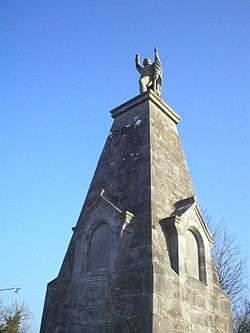Bartholomew Teeling
Captain Bartholomew Teeling (1774 in Lisburn, County Antrim, Ireland – 24 September 1798, in Arbor Hill, County Dublin, Ireland) was an Irish republican who was leader of the Irish forces during the Irish Rebellion of 1798 and who carried out an act of bravery during the Battle of Collooney. He was captured at the Battle of Ballinamuck and executed for treason.
_p450_BARTHOLOMEW_TEELING.jpg)
Background
Teeling, the son of a wealthy Catholic linen manufacturer in Lisburn, County Down, was educated at the Dubordieu School in Lisburn and at Trinity College Dublin. His younger brother Charles Teeling (1778–1850) went on to be a writer.
In 1795 the two brothers joined the United Irishmen and helped cement the republican movement's alliance with the Catholic Defenders.[1] In County Down, their brother-in-law, John Magennis, was the Defenders "Grand Master". In 1796 Batholomew travelled to France to encourage support for a French invasion of Ireland.
1798 Rebellion
Land at Killala
Teeling returned to Ireland on 22 August 1798, as Chief Aide de Camp to General Humbert, and landed at Killala Bay between County Sligo and Mayo with French troops. On 28 August the combined forces captured Castlebar and declared the Republic of Connacht. The Franco-Irish troops then pushed east through County Sligo but were halted by a cannon which the British forces had installed above Union Rock near Collooney.
Battle of Collooney
On 5 September 1798, Teeling cleared the way for the advancing Irish-French army by single handedly disabling a British gunner post during the Battle of Collooney in Sligo when he broke from the French ranks and galloped towards Union Rock. He was armed with a pistol and shot the cannon's marksman and captured the cannon. The French and Irish advanced and the British, after losing the cannon position, retreated towards their barracks at Sligo, leaving 60 dead and 100 prisoners.[2][3]
Battle of Ballinamuck
During the Battle of Ballinamuck at Longford Teeling and approximately 500 other Irishmen were captured along with their French allies. The French troops were treated as prisoners of war and later returned to France, however the Irish troops were executed by the British.
Teeling was court-martialled by Britain as an Irish rebel. To positively identify him, the authorities enlisted William Coulson, a damask manufacturer from Lisburn, who identified him as a son of Luke Teeling, a linen merchant who lived in Chapel Hill, Lisburn. Teeling was hanged at Arbour Hill Prison in Dublin.[4][5]
Teeling attempted to read the following statement from the scaffold, but was not permitted to:
"Fellow-citizens, I have been condemned by a military tribunal to suffer what they call an ignominious death, but what appears, from the number of its illustrious victims, to be glorious in the highest degree. It is not in the power of men to abase virtue nor the man who dies for it. His death must be glorious in the field of battle or on the scaffold.
The same Tribunal which has condemned me —Citizens, I do not speak to you here of the constitutional right of such a Tribunal, —has stamped me a traitor. If to have been active in endeavouring to put a stop to the blood-thirsty policy of an oppressive Government has been treason, I am guilty. If to have endeavoured to give my native country a place among the nations of the earth was treason, then I am guilty indeed. If to have been active in endeavouring to remove the fangs of oppression from the head of the devoted Irish peasant was treason, I am guilty.
Finally, if to have striven to make my fellow-men love each other was guilt, then I am guilty. You, my countrymen, may perhaps one day be able to tell whether these were the acts of a traitor or deserved death. My own heart tells me they were not and, conscious of my innocence, I would not change my present situation for that of the highest of my enemies.
Fellow-citizens, I leave you with the heartfelt satisfaction of having kept my oath as a United Irishman, and also with the glorious prospect of the success of the cause in which we have been engaged. Persevere, my beloved countrymen. Your cause is the cause of Truth. It must and will ultimately triumph."[6]

He is believed to have been buried at the mass grave of rebels at Croppies' Acre, Dublin.
Teeling monument
In 1898, the centenary year of the battle, a statue of Teeling was erected in Carricknagat. One of the main streets in Sligo Town, which accommodates the Sligo Courthouse and main Garda Síochána barracks was later named Teeling Street also in honour of Bartholomew Teeling.[7]
References
- Smyth, Jim (1998). The Men of No Property, Irish Radicals and Popular Politics in the Late Eighteenth Century. London: Macmillan. pp. 118–119.
- "Bartholomew Teeling biography". Brefine Tourism. Archived from the original on 28 September 2007. Retrieved 30 May 2007.
- Bill Peterson. "In the Footsteps of Général Humbert: The French Invasion of Ireland, 1798". The Napoleonic Wargaming Club. Archived from the original on 31 January 2008. Retrieved 30 May 2007.
- Aengus O Snodaigh. "Croppies Acre". An Phoblacht. Retrieved 30 May 2007.
- "1798 Rebellion". Lisburn.com. Retrieved 30 May 2007.
- Speeches From the Dock, or Protests of Irish Patriotism, by Seán Ua Cellaigh, Dublin, 1953
- Paul Gunning. "Walking Tour of Sligo". Discover Sligo. Archived from the original on 30 September 2007. Retrieved 30 May 2007.